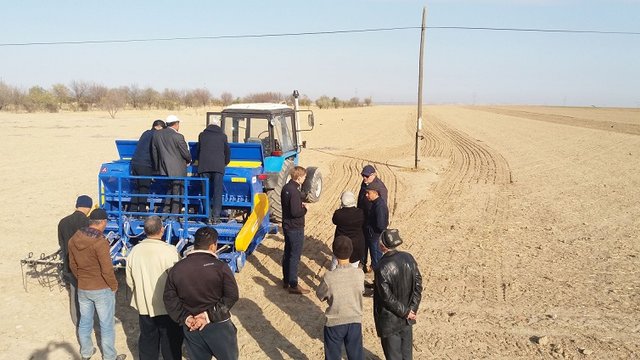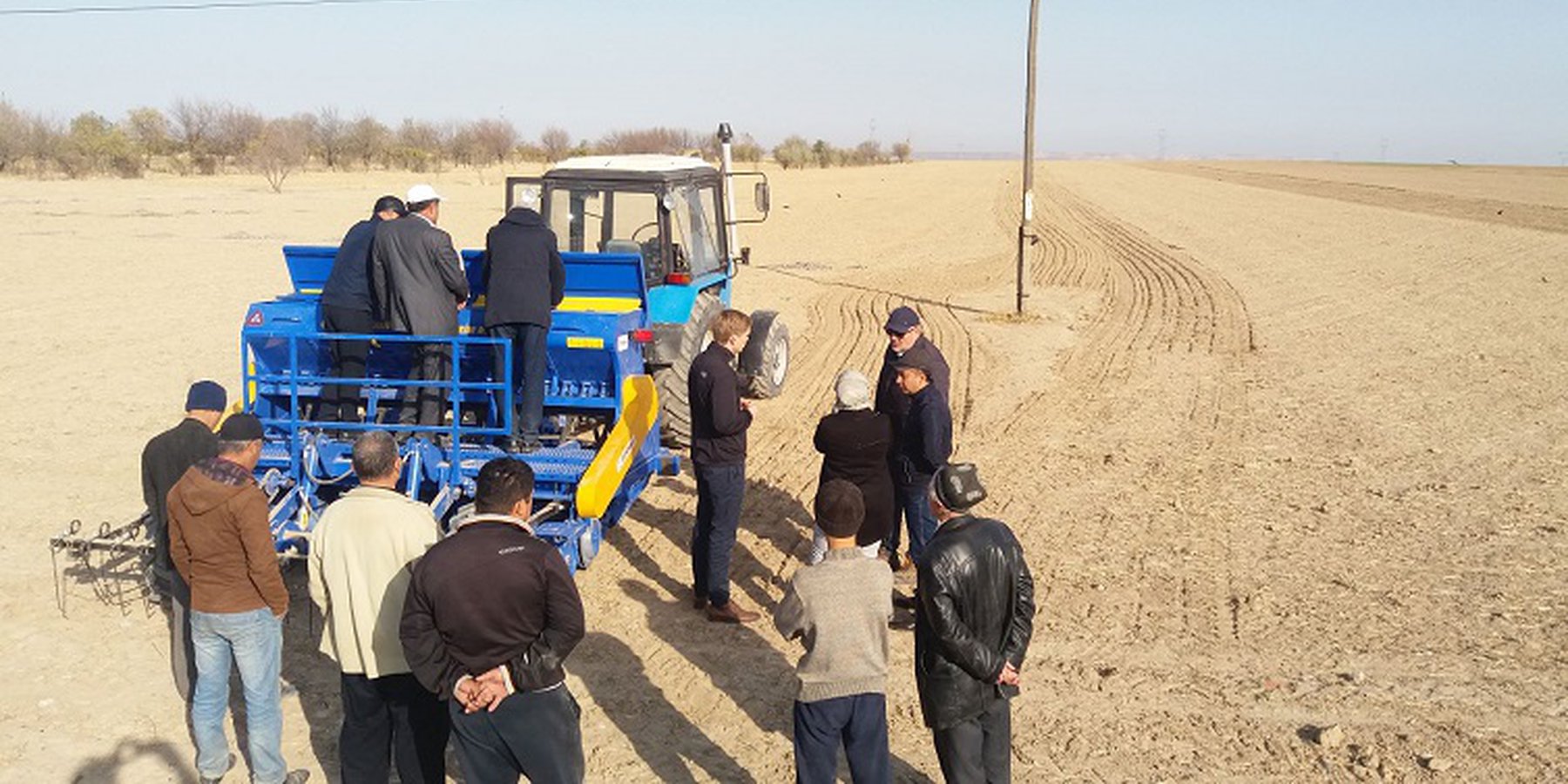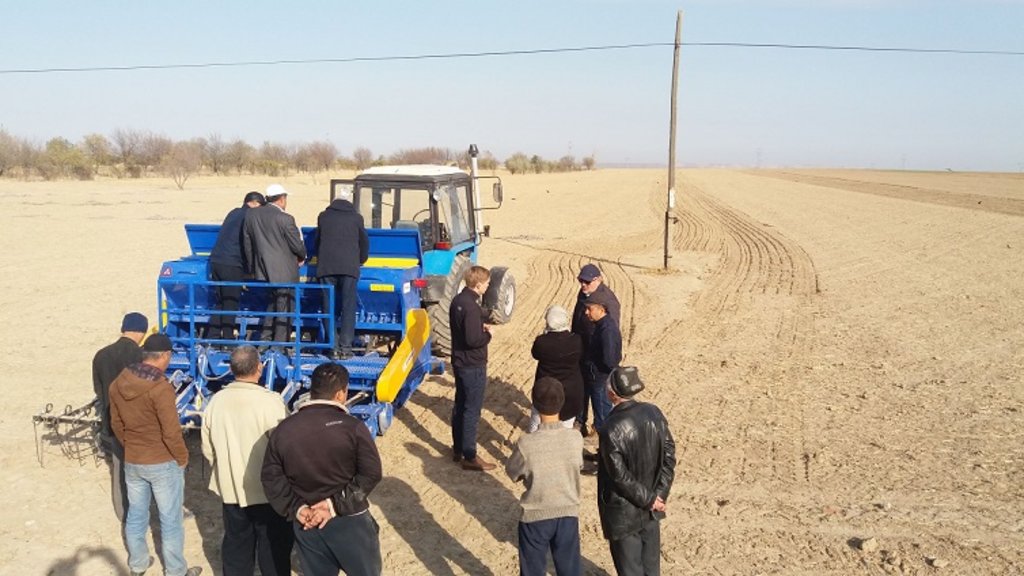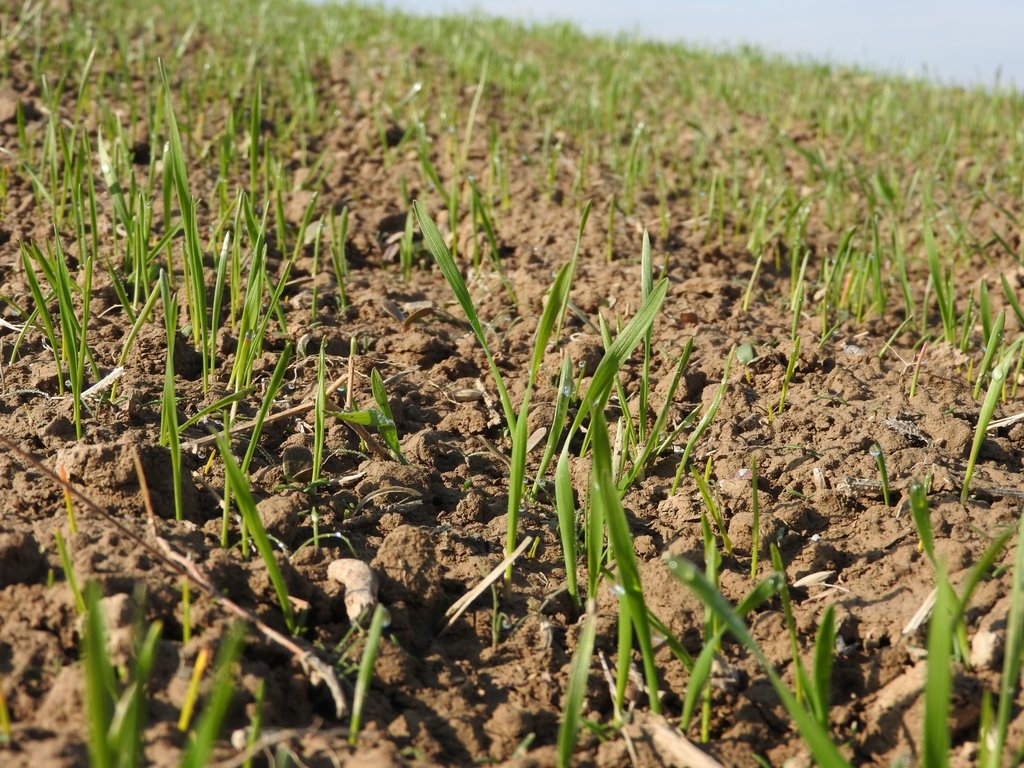Applying zero tillage technology for climate change sensitive rain-fed arable farming [塔吉克斯坦]
- 创建:
- 更新:
- 编制者: Stefan Michel
- 编辑者: –
- 审查者: Umed Vahobov
Примение безпахотной технологии для богарного земледелия, адаптированной к изменениям климата
technologies_4303 - 塔吉克斯坦
查看章节
全部展开 全部收起1. 一般信息
1.2 参与该技术评估和文件编制的资源人员和机构的联系方式
关键资源人
SLM专业人员:
Negmatov Negmatjon
Deutsche Gesellschaft für Internationale Zusammenarbeit (GIZ)
塔吉克斯坦
有助于对技术进行记录/评估的项目名称(如相关)
Strengthening of Livelihoods through Climate Change Adaptation in Kyrgyzstan and Tajikistan有助于对技术进行记录/评估的机构名称(如相关)
Deutsche Gesellschaft für Internationale Zusammenarbeit - Tajikistan (GIZ Tajikistan) - 塔吉克斯坦1.3 关于使用通过WOCAT记录的数据的条件
编制者和关键资源人员接受有关使用通过WOCAT记录数据的条件。:
是
1.4 所述技术的可持续性声明
这里所描述的技术在土地退化方面是否存在问题,导致无法被认为是一种可持续的土地管理技术?:
否
1.5 参考关于SLM方法(使用WOCAT记录的SLM方法)的调查问卷

Integrated rain-fed farming of cereals for adaptation to … [塔吉克斯坦]
Rain-fed agriculture faces challenges from climate change impact, inappropriate crop varieties and inadequate inputs. The approach of integrated rain-fed farming reduces the adverse effect of climate change impacts and improves the income of farmers.
- 编制者: Stefan Michel
2. SLM技术的说明
2.1 技术简介
技术定义:
Direct sowing and application of fertilizer without ploughing reduces land degradation risks associated with conventional arable farming and saves costs for farmers while improving the resilience against climate change impact, in particular drought.
2.2 技术的详细说明
说明:
By zero tillage technology (also called direct seeding, direct sowing or direct drilling) seed of cultivated crops is placed without mechanical treatment of the topsoil. Within one operation the residues from previous crops and weeds are superficially removed, seeds are planted, fertilizer applied and covered by soil. For the purpose of weed control the field is ploughed every third year. Also herbizides are used for weed control. The special drilling machine used for this provides the opportunity of regulating the density of sowing and the dosage of applied fertilizer in accordance to the yield potential of the site, which is typically determined by soils fertility and moisture.
In comparison with the traditional methods of arable farming the application of the zero tillage technology (direct drilling) reduces the following risks from the ecology and agronomy point of view: soil compaction, lump formation, destruction of the soil and dust formation, and manifestation of water and wind erosion. Also, the decrease of organic matter and the destruction of the habitat of soil organisms caused by intensive mechanical soil treatment are reduced. The avoiding of breaking up and turning the upper soil horizon hampers the evaporation from the soil surface and increases the soil moisture.
From the economic perspective, with the use of zero tillage technology (direct sowing) farmers can save the expenses for ploughing, leveling, chiseling that significantly reduces the costs of farmers. Improved soil moisture reduces drought-related risks of rain-fed winter wheat farming. Despite the fact, that the season of 2017-2018 was unusually dry and cold, the direct drilling technology showed good result impressing local farmers.
The technology has been demonstrated at two demo plots (each 2.5 hectares) for cultivation of wheat crop, established in Devashtich district during the 2017 agriculture season. To ensure longer-term sustainability of the idea and quick dissemination among the farmers, the local Non-commercial cooperative “Agra va iqlim” was engaged as a local partner, which has been assisted in the purchase of a combined drilling and fertilizing machine (“Özdöken”, Made in Turkey). Additionally wheat varieties have been provided, which are particularly suitable for rain-fed farming and can cope with due to climate change increasing aridity in the area: “Sultan” (Turkey), “Sarvar” (Tajikistan), “Krasnodar99” and “Moskovskiy93” (Russia). These varieties are high growing and provide a good amount of straw, which is in high demand by livestock owners in the region (1.7 TJS per kg).
As a result, during the agricultural season 2017/2018 already 50 involved farmers applied the technology for 50 hectares of rain-fed land for winter wheat. During 2018/2019 an expansion of involved farmers to approx. 150 and of the coverage area to 150 hectares of land for cultivation of winter wheat is planned.
2.3 技术照片
2.5 已应用该技术的、本评估所涵盖的国家/地区/地点
国家:
塔吉克斯坦
区域/州/省:
Sughd region
有关地点的进一步说明:
J. Rasulov district and Istaravshan district
具体说明该技术的分布:
- 适用于特定场所/集中在较小区域
技术现场是否位于永久保护区?:
否
Map
×2.6 实施日期
注明实施年份:
2017
如果不知道确切的年份,请说明大概的日期:
- 不到10年前(最近)
2.7 技术介绍
详细说明该技术是如何引入的:
- 通过项目/外部干预
3. SLM技术的分类
3.1 该技术的主要目的
- 改良生产
- 减少、预防、恢复土地退化
- 适应气候变化/极端天气及其影响
- 创造有益的经济影响
3.2 应用该技术的当前土地利用类型
同一土地单元内混合使用的土地::
否

农田
- 一年一作
年作 - 具体指明作物:
- 谷类 - 大麦
- 谷类 - 小麦(春季)
- 谷类 - 小麦(冬季)
- 油料作物 - 向日葵、菜籽、其他
每年的生长季节数:
- 1
采用间作制度了吗?:
否
采用轮作制度了吗?:
否
3.3 由于技术的实施,土地使用是否发生了变化?
由于技术的实施,土地使用是否发生了变化?:
- 否(继续问题3.4)
3.4 供水
该技术所应用土地的供水:
- 雨养
3.5 该技术所属的SLM组
- 最小的土壤扰动
3.6 包含该技术的可持续土地管理措施

农艺措施
- A3:土壤表面处理
- A5:种子管理,改良品种
- A6:残株管理
A3:区分耕作制度:
A 3.1:免耕
A6:对残株管理作出具体说明:
A 6.3:收集
3.7 该技术强调的主要土地退化类型

土壤水蚀
- Wt:表土流失/地表侵蚀
- Wg:冲沟侵蚀/沟蚀

土壤风蚀
- Et:表土流失

水质恶化
- Ha:干旱化
3.8 防止、减少或恢复土地退化
具体数量名该技术与土地退化有关的目标:
- 减少土地退化
4. 技术规范、实施活动、投入和成本
4.2 有关投入和成本计算的一般信息
具体说明成本和投入是如何计算的:
- 每个技术区域
注明尺寸和面积单位:
ha
其它/国家货币(具体说明):
TJS
如相关,注明美元与当地货币的汇率(例如1美元=79.9巴西雷亚尔):1美元=:
8.0
4.3 技术建立活动
| 活动 | 时间(季度) | |
|---|---|---|
| 1. | Purchase of drilling machine |
4.4 技术建立所需要的费用和投入
| 对投入进行具体说明 | 单位 | 数量 | 单位成本 | 每项投入的总成本 | 土地使用者承担的成本% | |
|---|---|---|---|---|---|---|
| 设备 | Drilling machine | 1.0 | 140500.0 | 140500.0 | ||
| 技术建立所需总成本 | 140500.0 | |||||
| 技术建立总成本,美元 | 17562.5 | |||||
注释:
The investment for the purchase of the drilling machine was made by the project. The machine is owned and leased to farmers by the extension service of "Agra va iqlim". Farmers pay for the use of the machine and these revenues will be used for maintenance, future replacement of the machine and purchase of additional machines as demand grows due to the spread of the technology.
4.5 维护/经常性活动
| 活动 | 时间/频率 | |
|---|---|---|
| 1. | Application of herbizides | |
| 2. | Combined drilling, fertilizer application and removal of residues | November or March / once |
| 3. | Fertilizing | Spring, once |
| 4. | Harvest | June - August |
4.6 维护/经常性活动所需要的费用和投入(每年)
| 对投入进行具体说明 | 单位 | 数量 | 单位成本 | 每项投入的总成本 | 土地使用者承担的成本% | |
|---|---|---|---|---|---|---|
| 设备 | Drilling machine services | ha | 1.0 | 380.0 | 380.0 | 100.0 |
| 设备 | Services for spraying herbicides and other pesticides | ha | 1.0 | 100.0 | 100.0 | 100.0 |
| 设备 | Fertilizer application | ha | 1.0 | 150.0 | 150.0 | 100.0 |
| 植物材料 | Wheat seeds | kg | 200.0 | 3.2 | 640.0 | 100.0 |
| 肥料和杀菌剂 | AmmoPhos | kg | 100.0 | 3.75 | 375.0 | 100.0 |
| 肥料和杀菌剂 | CarbamidN | kg | 100.0 | 3.0 | 300.0 | 100.0 |
| 肥料和杀菌剂 | Herbicide Granstar WDG | kg | 0.02 | 2000.0 | 40.0 | 100.0 |
| 肥料和杀菌剂 | Herbicide Dezormon 600 (2.4-D amine salt) | l | 0.8 | 100.0 | 80.0 | 100.0 |
| 肥料和杀菌剂 | Fungicide Tilt EC | l | 0.5 | 270.0 | 135.0 | 100.0 |
| 技术维护所需总成本 | 2200.0 | |||||
| 技术维护总成本,美元 | 275.0 | |||||
注释:
The capacity of the drilling machine is 150 ha per season, during one year - winter and summer season - it can reach 300 ha.
4.7 影响成本的最重要因素
描述影响成本的最决定性因素:
The costs of machinery and fuel for cultivation of the soil are substantial. The zero tillage technology allows for saving of 75-80% of these costs.
5. 自然和人文环境
5.1 气候
年降雨量
- < 250毫米
- 251-500毫米
- 501-750毫米
- 751-1,000毫米
- 1,001-1,500毫米
- 1,501-2,000毫米
- 2,001-3,000毫米
- 3,001-4,000毫米
- > 4,000毫米
指定年平均降雨量(若已知),单位为mm:
440.00
有关降雨的规范/注释:
According to Mr. Mamadyorov, the Head of the Agricultural department of Devashtich district annual rainfall in the rain-fed areas is 250-300 mm only, of which rainfall during end April-May is most important, together with rainfall in fall and winter.
注明所考虑的参考气象站名称:
Ghonchi
农业气候带
- 半干旱
5.2 地形
平均坡度:
- 水平(0-2%)
- 缓降(3-5%)
- 平缓(6-10%)
- 滚坡(11-15%)
- 崎岖(16-30%)
- 陡峭(31-60%)
- 非常陡峭(>60%)
地形:
- 高原/平原
- 山脊
- 山坡
- 山地斜坡
- 麓坡
- 谷底
垂直分布带:
- 0-100 m a.s.l.
- 101-500 m a.s.l.
- 501-1,000 m a.s.l.
- 1,001-1,500 m a.s.l.
- 1,501-2,000 m a.s.l.
- 2,001-2,500 m a.s.l.
- 2,501-3,000 m a.s.l.
- 3,001-4,000 m a.s.l.
- > 4,000 m a.s.l.
5.3 土壤
平均土层深度:
- 非常浅(0-20厘米)
- 浅(21-50厘米)
- 中等深度(51-80厘米)
- 深(81-120厘米)
- 非常深(> 120厘米)
土壤质地(表土):
- 中粒(壤土、粉土)
土壤质地(地表以下> 20厘米):
- 中粒(壤土、粉土)
表土有机质:
- 中(1-3%)
5.4 水资源可用性和质量
地下水位表:
5-50米
地表水的可用性:
中等
该区域正在发生洪水吗?:
否
5.5 生物多样性
物种多样性:
- 低
栖息地多样性:
- 低
5.6 应用该技术的土地使用者的特征
定栖或游牧:
- 定栖的
生产系统的市场定位:
- 商业/市场
非农收入:
- 低于全部收入的10%
相对财富水平:
- 平均水平
个人或集体:
- 个人/家庭
- 合作社
机械化水平:
- 机械化/电动
性别:
- 女人
- 男人
土地使用者的年龄:
- 中年人
5.7 应用该技术的土地使用者使用的平均土地面积
- < 0.5 公顷
- 0.5-1 公顷
- 1-2 公顷
- 2-5公顷
- 5-15公顷
- 15-50公顷
- 50-100公顷
- 100-500公顷
- 500-1,000公顷
- 1,000-10,000公顷
- > 10,000公顷
这被认为是小规模、中规模还是大规模的(参照当地实际情况)?:
- 小规模的
- 中等规模的
5.8 土地所有权、土地使用权和水使用权
土地所有权:
- 州
土地使用权:
- 租赁
- 个人
土地使用权是否基于传统的法律制度?:
否
5.9 进入服务和基础设施的通道
健康:
- 贫瘠
- 适度的
- 好
教育:
- 贫瘠
- 适度的
- 好
技术援助:
- 贫瘠
- 适度的
- 好
就业(例如非农):
- 贫瘠
- 适度的
- 好
市场:
- 贫瘠
- 适度的
- 好
能源:
- 贫瘠
- 适度的
- 好
道路和交通:
- 贫瘠
- 适度的
- 好
饮用水和卫生设施:
- 贫瘠
- 适度的
- 好
金融服务:
- 贫瘠
- 适度的
- 好
6. 影响和结论性说明
6.1 该技术的现场影响
社会经济效应
生产
作物生产
SLM之前的数量:
1-1.1 t/ha
SLM之后的数量:
1.2-1.5 t/ha
注释/具体说明:
Drought year - higher production increase possible in good years.
收入和成本
农业投入费用
SLM之前的数量:
2630 TJS/ha
SLM之后的数量:
2200 TJS/ha
注释/具体说明:
Reduction of expenses for soil cultivation, sowing and application of fertilizer.
生态影响
水循环/径流
蒸发
土壤
土壤水分
土壤流失
土壤有机物/地下C
6.2 该技术的场外影响已经显现
下游淤积
6.3 技术对渐变气候以及与气候相关的极端情况/灾害的暴露和敏感性(土地使用者认为的极端情况/灾害)
渐变气候
渐变气候
| 季节 | 增加或减少 | 该技术是如何应对的? | |
|---|---|---|---|
| 季节性温度 | 夏季 | 增加 | 好 |
| 季雨量 | 湿季/雨季 | 减少 | 好 |
6.4 成本效益分析
技术收益与技术建立成本相比如何(从土地使用者的角度看)?
短期回报:
积极
长期回报:
积极
技术收益与技术维护成本/经常性成本相比如何(从土地使用者的角度看)?
短期回报:
积极
长期回报:
积极
注释:
Initial investment in machinery covered by external funding, recovery of costs and expension by payments for use of machinery by farmers.
6.5 技术采用
- 1-10%
如若可行,进行量化(住户数量和/或覆盖面积):
2017/2018 - 50, 2018/2019 - 150
在所有采用这项技术的人当中,有多少人是自发的,即未获得任何物质奖励/付款?:
- 91-100%
6.6 适应
最近是否对该技术进行了修改以适应不断变化的条件?:
否
6.7 该技术的优点/长处/机会
| 土地使用者眼中的长处/优势/机会 |
|---|
| Reduced number of operations for soil cultiviation and related cost reduction. |
| Higher yield in drough year compared to conventionally cultivated fields. |
| Technology can make rain-fed arable farming less risky. |
| 编制者或其他关键资源人员认为的长处/优势/机会 |
|---|
| Reduced number of operations for soil cultiviation and related cost reduction. Higher yield. Better resilience to climate change impact, in particular to drought. |
| Reduced soil erosion, higher accumulaton of soil organic matter, preservation of soil organisms, reduced evaporation and more retained humidity. |
| Potential for expansion in terms of area, application in other crops. |
6.8 技术的弱点/缺点/风险及其克服方法
| 土地使用者认为的弱点/缺点/风险 | 如何克服它们? |
|---|---|
| Perceived reduced infiltration compared to ploughing. | Perception changed by observation on demonstration plots. |
| Potentially increasing weed abundance. | Annual application of herbicides and ploughing every third year. |
| 编制者或其他关键资源人员认为的弱点/缺点/风险 | 如何克服它们? |
|---|---|
| Crop residues on the soil surface can spread straw-borne diseases | Crop residues are minimized by collecting and using of straw. |
| Uneven distribution of harvest residues cannot be corrected | Drilling machine used for redistribution of residues. |
| Weeds have to be controlled with chemicals | Use of herbicides with proofen minimum impact and persistence. |
| Wheel tracks and soil compaction cannot be mechanically repaired | Ploughing every three years. |
7. 参考和链接
7.1 信息的方法/来源
- 实地考察、实地调查
- 与土地使用者的访谈
- 与SLM专业人员/专家的访谈
- 根据报告和其他现有文档进行编译
链接和模块
全部展开 全部收起链接

Integrated rain-fed farming of cereals for adaptation to … [塔吉克斯坦]
Rain-fed agriculture faces challenges from climate change impact, inappropriate crop varieties and inadequate inputs. The approach of integrated rain-fed farming reduces the adverse effect of climate change impacts and improves the income of farmers.
- 编制者: Stefan Michel
模块
无模块








